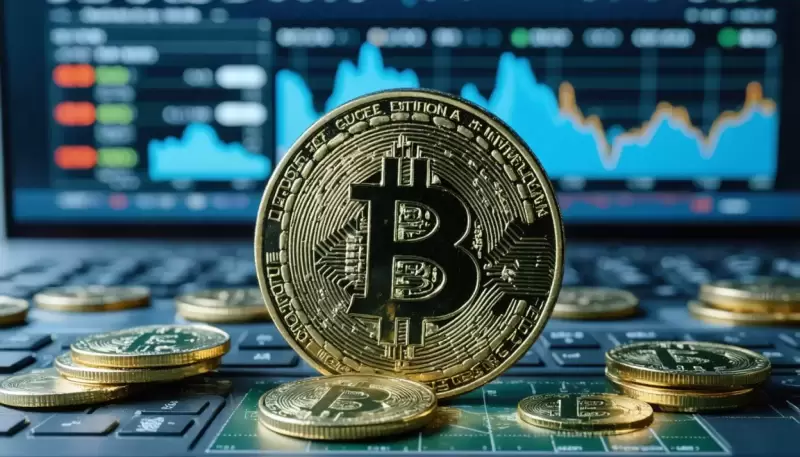 |
|
 |
|
 |
|
 |
|
 |
|
 |
|
 |
|
 |
|
 |
|
 |
|
 |
|
 |
|
 |
|
 |
|
 |
|
在4月2日特朗普的關稅宣布之後,比特幣急劇下降,一周內從84,600美元到75,000美元。

For many years after its inception, bitcoin was seen as an investment that traded unlike traditional assets. But as the cryptocurrency’s tumble thanks to US President Donald Trump’s tariffs demonstrates, these days, it’s trading much like any other risky investment.
成立後的許多年,比特幣被視為一種與傳統資產不同的投資。但是,由於美國總統唐納德·特朗普(Donald Trump)的關稅所證明的那樣,加密貨幣的流失表明,如今,它的交易就像其他任何風險投資一樣。
Indeed, bitcoin fell sharply in the wake of Trump’s tariff announcement on April 2, going from $84,600 to $75,000 within a week. That plunge extended declines that began in February. On January 30, bitcoin was worth over $106,000 after a blistering post-election rally. This drop coincided with a selloff in US stocks, especially technology names. During the week following Trump’s announcement on tariffs, bitcoin shed 10.5%, very close to the 11.6% lost by the S&P 500 and 12.0% by the Nasdaq 100.
的確,在4月2日特朗普的關稅宣布之後,比特幣急劇下降,一周內從84,600美元到75,000美元。這種暴跌從2月開始的下降量擴大。 1月30日,經過大選後的激烈集會,比特幣價值超過106,000美元。這種下降恰逢美國股票的拋售,尤其是技術名稱。在特朗普宣布關稅之後的一周中,比特幣降低了10.5%,非常接近標準普爾500指數的11.6%,納斯達克100損失了12.0%。
“Bitcoin’s heightened correlation with the Nasdaq and S&P 500 reflects its evolving role as a macro-sensitive asset, driven by institutional behavior and policy shifts,” says Adrian Fritz, head of research at 21Shares, a specialized provider of crypto ETPs. “Institutional investors now treat bitcoin similarly to tech stocks, leading to synchronized trading patterns during macroeconomic events. This alignment intensified under Trump’s pro-crypto agenda.”
“比特幣與納斯達克和標準普爾500指數的增強相關性反映了其作為宏觀敏感資產的不斷發展的作用,這是由機構行為和政策變化驅動的。” Crypto ETP的專業提供者21Shares的研究主管Adrian Fritz說。 “現在的機構投資者對比特幣類似地對待比特幣,從而導致宏觀經濟事件期間的同步交易模式。根據特朗普的親克萊普托議程,這種一致性加劇了。”
“Bitcoin might be decentralized, but it does not trade in a vacuum,” explains WisdomTree digital assets research director Dovile Silenskyte. “When macro fear spikes, it gets hit like everything else.”
WisdomTree數字資產研究總監Dovile Silenskyte解釋說:“比特幣可能是分散的,但不會以真空交易。” “當宏觀恐懼尖峰時,它會像其他一切一樣被打擊。”
Trump’s Tariffs and Bitcoin
特朗普的關稅和比特幣
Trump’s promises to make the United States the new “bitcoin hub” attracted institutional capital, but they also bound bitcoin to political risks impacting traditional markets. Over the past quarter, this evolving relationship has solidified bitcoin’s status as a risk-on asset, says Fritz.
特朗普承諾使美國新的“比特幣中心”吸引了機構資本,但它們也將比特幣限制在影響傳統市場的政治風險中。弗里茨說,在過去的一個季度中,這種不斷發展的關係鞏固了比特幣作為風險對準資產的地位。
Thus, when the tariffs sparked a global flight to safety, investors rapidly exited both equities and bitcoin, triggering parallel 15% declines in BTC, the Nasdaq, and the S&P 500 as capital mainly rotated into safer havens like gold.
因此,當關稅引發了全球安全的航班時,投資者迅速退出了股票和比特幣,觸發了BTC,納斯達克股票和標準普爾500指數的15%下降,因為資本主要旋轉成像黃金這樣的更安全的避風港。
At the same time, when news broke of a 90-day suspension of the tariffs and suddenly the risk-on sentiment came roaring back, bitcoin surged in line with a rally across equities. On April 9, BTC gained 8.2%, while the S&P 500 rallied 9.5%. This rebound was not about crypto fundamentals, it was a classic macro-driven relief rally, showing just how plugged-in bitcoin is to the broader market narrative, says Silenskyte.
同時,當新聞打破了90天的關稅暫停,突然,風險持續的情緒又回來了,比特幣與跨股票的集會一致。 4月9日,BTC上漲了8.2%,而標準普爾500指數上漲了9.5%。 Silenskyte說,這種反彈不是關於加密基礎知識的,它是一個經典的宏觀驅動浮雕集會,顯示了比特幣對更廣泛的市場敘事的插件。
For Ferdinando Ametrano, managing director of CheckSig and a professor of Bitcoin and Blockchain Technology at Milan-Bicocca University, bitcoin is a thermometer of globalization, sensitive to international scenarios. One part of the market likens it to North American tech stocks. Another part sees it as digital gold, a safe haven asset. Whoever is right will become clearer in the future. As of today, in the tensest moments, the association with equities typical of the most active market participants prevails, since the other component has a buy-and-hold approach.
對於米蘭 - 比科卡大學(Milan-Bicocca University)的Checksig和比特幣和區塊鏈技術教授Ferdinando Ametrano,比特幣是全球化的溫度計,對國際情景敏感。市場的一部分將其比作北美科技股。另一部分將其視為避風港資產的數字黃金。無論誰是對的人,將來都會變得更加清晰。截至今天,在最緊張的時刻,與最活躍的市場參與者典型的股票交往佔上風,因為另一個組件採用買入和持有的方法。
Bitcoin Much Less Volatile Than in the Past
比特幣比過去的波動率要少得多
Despite the recent swings seen in bitcoin, some point to data suggesting the cryptocurrency has become less volatile.
儘管最近在比特幣中看到了波動,但某種數據表明,加密貨幣的波動性降低了。
Over the past five years, bitcoin’s 90-day annualized volatility has been cut nearly in half, from 95% in March 2021 to 52% in March 2025, says Silenskyte. This lower volatility coincides with a structural shift toward institutionalization.
Silenskyte說,在過去的五年中,比特幣的90天的年度波動率將幾乎減少了一半,從2021年3月的95%降至2025年3月的52%。這種較低的波動率與向制度化的結構轉變一致。
This shift is driven by the development of regulated financial instruments such as spot bitcoin ETFs, options contracts, and volatility-linked derivatives, which enable sophisticated strategies like basis trading and risk-hedged exposure, says Fritz. Major financial institutions are now allocating portions of their portfolios to digital assets. Such institutional footprint has gradually displaced retail-driven speculation, fostering a market structure with tighter bid-ask spreads and reduced gap risks compared with previous cycles, and concurrently reduced bitcoin’s historical volatility.
Fritz說,這種轉變是由諸如現貨比特幣ETF,期權合約和與波動率關聯的衍生品這樣的規范金融工具的開發驅動的,這使得諸如基礎交易和風險對沖風險敞口之類的複雜策略。現在,主要的金融機構正在將其投資組合的部分分配給數字資產。與以前的周期相比,這種機構足跡逐漸流離失所,以更嚴格的出價差異和差距風險降低,並同時降低了比特幣的歷史波動率,從而逐漸流離失所。
This lower volatility is also partly due to the fact that bitcoin is a 24/7-traded asset, which means it consistently attracts liquidity, leading to deeper market structures, says Max Shannon, research analyst at CoinShares. As institutional participation grows and market infrastructure matures, this increased depth is gradually helping to reduce the asset’s historical volatility.
Coinshares的研究分析師Max Shannon說,這種較低的波動性也部分是由於比特幣是24/7貿易資產,這意味著它始終吸引流動性,從而導致更深層次的市場結構。隨著機構參與的增長和市場基礎設施的成熟,這種增加的深度逐漸有助於減少資產的歷史波動。
What to Expect From Bitcoin Prices Now?
現在對比特幣價格有什麼期望?
Trump is the first openly pro-crypto US president, and his second term is expected to usher in a friendlier policy environment for crypto markets. But that doesn’t mean it will all be smooth sailing from here.
特朗普是美國第一個公開支持的美國總統,他的第二任期有望為加密市場帶來更友好的政策環境。但這並不意味著從這裡開始航行將是順利的。
Investors should expect both volatility and opportunity, says Silenskyte, who adds that macro liquidity remains the single most powerful force in markets and bitcoin is no exception.
Silenskyte說,投資者應該期望波動和機會,他補充說,宏流動性仍然是市場上最強大的力量,比特幣也不例外。
Apart from the introduction of favorable
除了引入有利
免責聲明:info@kdj.com
所提供的資訊並非交易建議。 kDJ.com對任何基於本文提供的資訊進行的投資不承擔任何責任。加密貨幣波動性較大,建議您充分研究後謹慎投資!
如果您認為本網站使用的內容侵犯了您的版權,請立即聯絡我們(info@kdj.com),我們將及時刪除。
-

-

-

- 9個加密貨幣在接下來的幾天內觀看
- 2025-04-21 04:10:14
- 隨著加密貨幣市場的不斷發展,解鎖或代幣發行在確定加密貨幣的下一個大型動作中起著至關重要的作用。
-

- 目前,加密貨幣市場仍然柔和,沒有明顯的催化劑來向任何方向推動價格。
- 2025-04-21 04:10:14
- 目前,加密貨幣市場仍然柔和,沒有明顯的催化劑來向任何方向推動價格。
-

-

- 比特幣:全球經濟拔河比賽中不太可能的避難所
- 2025-04-21 04:05:13
- 美國和中國之間的猛烈經濟拔河架架,最初是由特朗普政府的關稅點燃的
-

-

- Filecoin(FIL)繼續在下降通道內合併
- 2025-04-21 04:00:13
- Filecoin價格預測表明,FIL目前正在下降渠道內交易,顯示了合併的跡象,因為它在關鍵移動平均之間波動。
-

- Solaxy Presale超過3000萬美元,展示了該項目的爆炸性增長潛力
- 2025-04-21 03:55:13
- 這標誌著該項目取得了巨大的成功,很明顯,這是一個機會,任何投資者都不會錯過。



























































